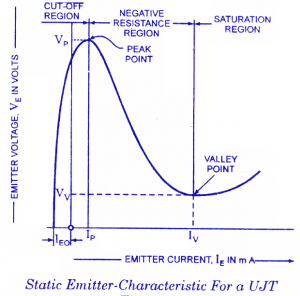UJT Characteristics
The static emitter characteristic (a curve showing the relation between emitter voltage VE and emitter current IE) of a UJT at a given inter base voltage VBB is shown in figure. From figure it is noted that for emitter potentials to the left of peak point, emitter current IE never exceeds IEo . The current IEo corresponds very closely to the reverse leakage current ICo of the conventional BJT. This region, as shown in the figure, is called the cut-off region. Once conduction is established at VE = VP the emitter potential VE starts decreasing with the increase in emitter current IE. This Corresponds exactly with the decrease in resistance RB for increasing current IE. This device, therefore, has a negative resistance region which is stable enough to be used with a great deal of reliability in the areas of applications listed earlier. Eventually, the valley point reaches, and any further increase in emitter current IE places the device in the saturation region, as shown in the figure. Three other important parameters for the UJT are IP, VV and IV and are defined below:
Peak-Point Emitter Current. Ip. It is the emitter current at the peak point. It represents the rnimrnum current that is required to trigger the device (UJT). It is inversely proportional to the interbase voltage VBB.
Valley Point Voltage VV The valley point voltage is the emitter voltage at the valley point. The valley voltage increases with the increase in interbase voltage VBB.
Valley Point Current IV The valley point current is the emitter current at the valley point. It increases with the increase in inter-base voltage VBB.
Special Features of UJT. The special features of a UJT are :
- A stable triggering voltage (VP)— a fixed fraction of applied inter base voltage VBB.
- A very low value of triggering current.
- A high pulse current capability.
- A negative resistance characteristic.
- Low cost.


5 Comments
VI characteristics of UJt are similar to which device?
thanks for that .
why the arrow is bended in UJT symboll?
i need some information about ‘the negative resistance possesing by ujt’
Thanks for such an informative website. When I grew up UJT was already out of fashion but I got to use it a number of times, without really understanding it. Now, the information about UJT is very rare…
Now, is there any other interesting/creative use of UJT? Guitar amp distortion unit?